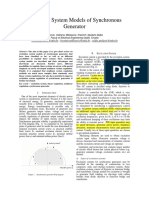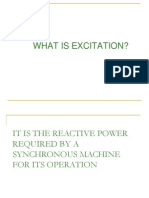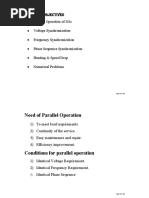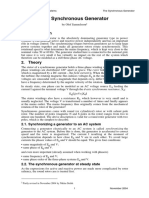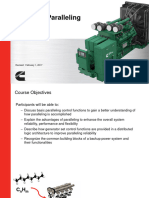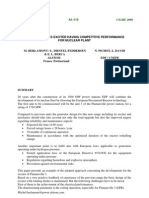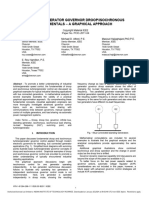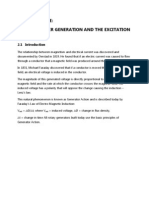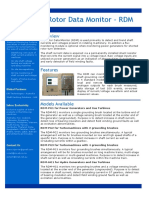Generator and Static Excitation
Uploaded by
mentongGenerator and Static Excitation
Uploaded by
mentongANSALDO
ANSALDO
THE SYNCHRONOUS GENERATOR (ALTERNATOR)
Synthetic notes
The synchronous generator (alternator) is a rotating electric machine which converts mechanical energy from the turbine into electric energy. The turbine converts some kind of energy (steam, water, gas) into mechanical energy
ANSALDO
The key principle is based on the electromagnetic induction phenomenon: a relative rotation between a magnetic inductor flux and a system of connected induced conductors.
PERMANENT MAGNET GENERATOR N
GENERATOR WITH EXCITATION N Iex +
In order to realize the relative movement between inductor and induced conductors the generator is constituted by a fixed part the stator and a rotating part the rotor. When the inductor conductor (rotor winding ) excited is turning at a fixed speed, an induced alternating voltage at the armature winding terminals (three phase winding) is produced: its frequency depends on the inductor rotating speed and its value ( RMS value) is proportional to the flux produced by the inductor according to the relationship E =k n The generator speed is proportionall to the frequency according to the following relationship: N = 120 X F ________ P N is the speed (rpm) , F is the frequency ( Hz) and P the number of poles.
ANSALDO
A synchronous generator representation
ANSALDO
Current anf Power If the external circuit of the generator is closed on a load a current will circulate in the armature windings. According to the phase angle between voltage and current, the generator can produce active power P and/or reactive power Q, in any case the rated power (nominal) is expressed in apparent power (MVA) which only depends from the product VOLTAGE X CURRENT. An=3*Vn*In and it means the generator power plate in KVA. The nominal current value depends on the section of the conductors and on the cooling system and is equal to the maximum continous operating current. The nominal voltage value depends on the number of the induced conductors and on the dimensions of the magnetic circuits ( maximum flux).
ANSALDO
Excitation The inductor circuit (called field winding or rotor winding or field circuit) of the synchronous generator is fed by a continuous voltage whose value is inclusive into a range between 100V and 500 Volt (Excitation voltage). The excitation power can vary from around 0.3 to 1.5% the rated power according to the number of poles. The energy's source for the excitation is almost exclusively constituted by rectifier device that converts energy ( AC / DC converter )
ANSALDO
The excitation system These are the most important functions of the excitation system : Supply the necessary energy to fed generator field circuit converting it from an external source. Regulate automatically, through the control of the excitation, the voltage at generator terminals .
Limitate the generator operation inside its operating ranges; Optimize the dynamics of generator connected to the net Regulate the excitation current in the manual mode
De- excite the generator after the stop request. (fast de- excitation)
ANSALDO
The generator NO LOAD CHARACTERISTIC :
It represents the generator voltage at no load as excitation current a function of the
ANSALDO
Generator
characteristic
: mathematical representation of NO LOAD
Curva di saturazione a vuoto approx.
14.95 IfolIfd0
11.213 Vm (kV)
Vnom
7.475
3.738
.
0 0 175 350 Ifd (Amp) 525 700
Ifol = no load air gap current ( A) Ifd0= no load current (A) Vnom = Nominal voltage
ANSALDO
REACTIVE POWER EXCHANGE WITH THE GRID
We suppose that the generator is connected to a infinite power grid (that has a voltage constant value= Vr through an uncoupling reactance X Case of inductive reactive power production to the grid. In this case, starting from an equilibrium condition whit Vr = Va (the voltages are represented as two vectors) and with the generator at no load, the value of the excitation current is increased the generator voltage Va is greater than Vr:
The generator produces inductive reactive power to the grid ( Q >0)
Vt _ Vr Ia Grid Ia Inductive load Vr Va
G Va
Vt X
Case of absorption of inductive reactive power from the grid (or of production of capacitive reactive power to the grid) In this case, starting from an equilibrium condition whith Vr = Va and with the generator at no load, the value of the excitation current is decreased the generator voltage Va is smaller than Vr:
The generator absorbs inductive reactive power from the grid ( Q < 0)
Vt G _ Va Ia Ia X + Vr Grid Vr
Vt Va
Capacitive load
10
ANSALDO
THE CAPABILITY DIAGRAM: is a diagram showing the operating limits of the generator
Max apparent power of the generator Inaccessible area due to stability and overheating of the stator core ends.
Active power Inaccessible area due to the turbine power limitation
Nominal work. point Max turbine power Inaccessible area due to the rotor overheating
Under excitation limit
Max rotor current limit
0 Under-excitation LEADING Over-excitation LAGGING
Reactive power
Motor
11
ANSALDO
THE STATIC EXCITATION SYSTEM A first classification of the EXCITATION systems is made on the basis of the power section that fed the generator field: the excitation system can be therefore static or rotating
the system is called called static because the field is fed from a static source without rotating parts, and statics rectifiers are used to product DC current. The static excitation system directly acts on the generator field using revolving contacts (brush-rings)
12
STATIC EXCITATION SYSTEM
ANSALDO
Generator
Three phase supply
Excitation board
Excitation transformer
.Actuallly the rotating excitation system ( brushless generator) are rarely used .
13
ANSALDO
BRUSHLESS EXCITATION
PERMANENT MAGNET GENERATOR
BRUSHLESS AUX GENERATOR
ROTATING DIODES BRIDGE MAIN GENERATOR
+ --
EXCITATION CUBICLE
14
ANSALDO
THE CONTROL INTERFACES Besides the power interfaces (see above) from the excitation transformer and to the rings, the excitation system must exchange signals with the external plant. Therefore a lot of control interfaces and therefore a lot of auxiliary connections with other plants equipments plant are realized automation automation protections protections
STATIC Excitation
plant plant
Plant means in general: interlocks, consents, commands to switchtes etc
15
ANSALDO
ADVANTAGES OF THE STATIC EXCITATION SYSTEM RELIABILITY OF THE STATIC COMPONENTS REDUNDANCE HIGH DINAMIC RESPONSE LOW LOSSES FAST DE EXCITATION SHORT TIME TO REPAIR DAMAGES SMALL DIMENSION . while the only advantage of a rotating excitation system is the absence of revolving contacts ( not accepted in particular environmental conditions )
16
ANSALDO
Static excitation system: power and control sections
Excitation system Line
3
Power supply
Gen brk
Power section
Output signals
~
Excitation feedback Generator feedback
Control section
Commands
Line feedback (option)
The system is composed by 2 sections functionally separated
- the power section that is directly connected to the rotor field generator. - the control section that guarantees the regulation of the main electrical greatness beginning from the measures of the greatness of the same generator.
17
ANSALDO
Static excitation system : Power and control sections details
converter power supply line
52G
line voltage synchronous voltages
power section crow bar converter control section = = = = = =
excitation current excitation voltage crow bar current machine voltage machine current
alpha
18
You might also like
- Training - Manual - Generator Control System 1100% (3)Training - Manual - Generator Control System 142 pages
- Excitation System: Neelum Jehlum Hydro Power Company100% (1)Excitation System: Neelum Jehlum Hydro Power Company12 pages
- 2-Pole Turbine Driven Generators - Brushless Excitation100% (3)2-Pole Turbine Driven Generators - Brushless Excitation2 pages
- Part-2 - Section 7 - Static Digital Excitation System - Particular Technical SpecificationNo ratings yetPart-2 - Section 7 - Static Digital Excitation System - Particular Technical Specification71 pages
- CH - Excitation Control Systems Bulletin PDF100% (1)CH - Excitation Control Systems Bulletin PDF12 pages
- Excitation Systems: This Material Should Not Be Used Without The Author's Consent100% (2)Excitation Systems: This Material Should Not Be Used Without The Author's Consent31 pages
- ATT04 HTCT623357 PFUPs For Static Starting Device Combi UnitNo ratings yetATT04 HTCT623357 PFUPs For Static Starting Device Combi Unit10 pages
- The Synchronous Generator: 2.1. Synchronizing A Generator To An AC SystemNo ratings yetThe Synchronous Generator: 2.1. Synchronizing A Generator To An AC System11 pages
- Volume B Operation Procedure of Plant Electrical Systems (HTOM-E-02)No ratings yetVolume B Operation Procedure of Plant Electrical Systems (HTOM-E-02)177 pages
- AGN142 - B Pole Slipping and Reverse PowerNo ratings yetAGN142 - B Pole Slipping and Reverse Power3 pages
- Insulator Testing of AC Generator WindingNo ratings yetInsulator Testing of AC Generator Winding4 pages
- Basler Elect Excitation System Upgrade Frame6UG09No ratings yetBasler Elect Excitation System Upgrade Frame6UG0953 pages
- Customer Specification: Static Excitation System (Ses)No ratings yetCustomer Specification: Static Excitation System (Ses)18 pages
- New Solutions For Brushless Exciter Rectifying Modules Reduce Down Time During OverhaulNo ratings yetNew Solutions For Brushless Exciter Rectifying Modules Reduce Down Time During Overhaul9 pages
- Justification Report For TRT GEX2000 NewNo ratings yetJustification Report For TRT GEX2000 New6 pages
- LSR, Auto Sync, Lmu, Tavt Testing Protocol100% (1)LSR, Auto Sync, Lmu, Tavt Testing Protocol19 pages
- If You Have A Speedtronic Mark IV or Mark V or Mark VI100% (1)If You Have A Speedtronic Mark IV or Mark V or Mark VI55 pages
- Synchronous Generator Capability Curve Testing and Evaluation100% (1)Synchronous Generator Capability Curve Testing and Evaluation11 pages
- Excitation Systems: This Material Should Not Be Used Without The Author's ConsentNo ratings yetExcitation Systems: This Material Should Not Be Used Without The Author's Consent31 pages
- Fig. 2 (A) Self Excited Induction GeneratorNo ratings yetFig. 2 (A) Self Excited Induction Generator7 pages
- Rotating Diodes Exciter Having Competitive Performance For Nuclear PlantNo ratings yetRotating Diodes Exciter Having Competitive Performance For Nuclear Plant9 pages
- Automatic Voltage Regulator For Synchronous GeneratorNo ratings yetAutomatic Voltage Regulator For Synchronous Generator7 pages
- Turbine Generator Governor Droop Isochronous Fundamentals - A Graphical ApproachNo ratings yetTurbine Generator Governor Droop Isochronous Fundamentals - A Graphical Approach8 pages
- 6 ABB SACE Solutions For Protection Against Earth Fault: General Aspects100% (1)6 ABB SACE Solutions For Protection Against Earth Fault: General Aspects33 pages
- Electric Power Generation and Excitation SystemNo ratings yetElectric Power Generation and Excitation System20 pages
- Reference Guide To Useful Electronic Circuits And Circuit Design Techniques - Part 1From EverandReference Guide To Useful Electronic Circuits And Circuit Design Techniques - Part 12.5/5 (3)
- Advantages and Applications of Zigzag Transformer - Engineering Tutorial PDFNo ratings yetAdvantages and Applications of Zigzag Transformer - Engineering Tutorial PDF4 pages
- ATS Training Outline: What Is A Transfer Switch? What Makes A Transfer Switch Reliable?No ratings yetATS Training Outline: What Is A Transfer Switch? What Makes A Transfer Switch Reliable?48 pages
- 6672 TransmissionLine DH 20150210 Web2 PDFNo ratings yet6672 TransmissionLine DH 20150210 Web2 PDF18 pages
- Advantages and Applications of Zigzag Transformer - Engineering Tutorial PDFNo ratings yetAdvantages and Applications of Zigzag Transformer - Engineering Tutorial PDF4 pages
- Ferroresonant Configurations in Power Systems: V. Valverde, G. Buigues, A. J. Mazón, I. Zamora, I. Albizu100% (1)Ferroresonant Configurations in Power Systems: V. Valverde, G. Buigues, A. J. Mazón, I. Zamora, I. Albizu6 pages
- The Seven Types of Power Problems: White Paper 18No ratings yetThe Seven Types of Power Problems: White Paper 1821 pages
- Why and Wherefores of Power System BlackoutsNo ratings yetWhy and Wherefores of Power System Blackouts6 pages
- SOCOMEC White Paper For Planning A DATA CENTRE Electrical InfrastructureNo ratings yetSOCOMEC White Paper For Planning A DATA CENTRE Electrical Infrastructure25 pages
- Preparation of Transformer Specifications1100% (1)Preparation of Transformer Specifications156 pages
- Fiber Optic Cable Joint and Measurement PDFNo ratings yetFiber Optic Cable Joint and Measurement PDF14 pages
- CSC-211 Multifunction Protection IED Technical Application Manual - V1.01No ratings yetCSC-211 Multifunction Protection IED Technical Application Manual - V1.01341 pages
- CSC-121 Breaker Protection IED Engineering and Operation Manual - V1.00No ratings yetCSC-121 Breaker Protection IED Engineering and Operation Manual - V1.00221 pages
- What Is The Cause of Generator Overfluxing and Overcxcitation - QuoraNo ratings yetWhat Is The Cause of Generator Overfluxing and Overcxcitation - Quora2 pages
- Alternadores LEROY SOMER Instalacion y Mantenimiento PDFNo ratings yetAlternadores LEROY SOMER Instalacion y Mantenimiento PDF22 pages
- 0 - Basics - Converter Drives Control - RemarksNo ratings yet0 - Basics - Converter Drives Control - Remarks35 pages
- Flyer - PCS-985B-AW Generator-Transformer Unit Protection PDFNo ratings yetFlyer - PCS-985B-AW Generator-Transformer Unit Protection PDF7 pages
- PSP, Modern Technologies and Large Scale PDFNo ratings yetPSP, Modern Technologies and Large Scale PDF11 pages
- PHYsics Class12 Project Report Cbse 2020 2021 On Topic Ac Generator PDFNo ratings yetPHYsics Class12 Project Report Cbse 2020 2021 On Topic Ac Generator PDF15 pages
- Kota Super Thermal Power Station, Kota: Submitted To: Submitted byNo ratings yetKota Super Thermal Power Station, Kota: Submitted To: Submitted by76 pages
- Excitation System: Neelum Jehlum Hydro Power CompanyExcitation System: Neelum Jehlum Hydro Power Company
- 2-Pole Turbine Driven Generators - Brushless Excitation2-Pole Turbine Driven Generators - Brushless Excitation
- Part-2 - Section 7 - Static Digital Excitation System - Particular Technical SpecificationPart-2 - Section 7 - Static Digital Excitation System - Particular Technical Specification
- Excitation Systems: This Material Should Not Be Used Without The Author's ConsentExcitation Systems: This Material Should Not Be Used Without The Author's Consent
- ATT04 HTCT623357 PFUPs For Static Starting Device Combi UnitATT04 HTCT623357 PFUPs For Static Starting Device Combi Unit
- The Synchronous Generator: 2.1. Synchronizing A Generator To An AC SystemThe Synchronous Generator: 2.1. Synchronizing A Generator To An AC System
- Volume B Operation Procedure of Plant Electrical Systems (HTOM-E-02)Volume B Operation Procedure of Plant Electrical Systems (HTOM-E-02)
- Customer Specification: Static Excitation System (Ses)Customer Specification: Static Excitation System (Ses)
- New Solutions For Brushless Exciter Rectifying Modules Reduce Down Time During OverhaulNew Solutions For Brushless Exciter Rectifying Modules Reduce Down Time During Overhaul
- If You Have A Speedtronic Mark IV or Mark V or Mark VIIf You Have A Speedtronic Mark IV or Mark V or Mark VI
- Synchronous Generator Capability Curve Testing and EvaluationSynchronous Generator Capability Curve Testing and Evaluation
- Excitation Systems: This Material Should Not Be Used Without The Author's ConsentExcitation Systems: This Material Should Not Be Used Without The Author's Consent
- Rotating Diodes Exciter Having Competitive Performance For Nuclear PlantRotating Diodes Exciter Having Competitive Performance For Nuclear Plant
- Automatic Voltage Regulator For Synchronous GeneratorAutomatic Voltage Regulator For Synchronous Generator
- Turbine Generator Governor Droop Isochronous Fundamentals - A Graphical ApproachTurbine Generator Governor Droop Isochronous Fundamentals - A Graphical Approach
- 6 ABB SACE Solutions For Protection Against Earth Fault: General Aspects6 ABB SACE Solutions For Protection Against Earth Fault: General Aspects
- Reference Guide To Useful Electronic Circuits And Circuit Design Techniques - Part 1From EverandReference Guide To Useful Electronic Circuits And Circuit Design Techniques - Part 1
- Advantages and Applications of Zigzag Transformer - Engineering Tutorial PDFAdvantages and Applications of Zigzag Transformer - Engineering Tutorial PDF
- ATS Training Outline: What Is A Transfer Switch? What Makes A Transfer Switch Reliable?ATS Training Outline: What Is A Transfer Switch? What Makes A Transfer Switch Reliable?
- Advantages and Applications of Zigzag Transformer - Engineering Tutorial PDFAdvantages and Applications of Zigzag Transformer - Engineering Tutorial PDF
- Ferroresonant Configurations in Power Systems: V. Valverde, G. Buigues, A. J. Mazón, I. Zamora, I. AlbizuFerroresonant Configurations in Power Systems: V. Valverde, G. Buigues, A. J. Mazón, I. Zamora, I. Albizu
- SOCOMEC White Paper For Planning A DATA CENTRE Electrical InfrastructureSOCOMEC White Paper For Planning A DATA CENTRE Electrical Infrastructure
- CSC-211 Multifunction Protection IED Technical Application Manual - V1.01CSC-211 Multifunction Protection IED Technical Application Manual - V1.01
- CSC-121 Breaker Protection IED Engineering and Operation Manual - V1.00CSC-121 Breaker Protection IED Engineering and Operation Manual - V1.00
- What Is The Cause of Generator Overfluxing and Overcxcitation - QuoraWhat Is The Cause of Generator Overfluxing and Overcxcitation - Quora
- Alternadores LEROY SOMER Instalacion y Mantenimiento PDFAlternadores LEROY SOMER Instalacion y Mantenimiento PDF
- Flyer - PCS-985B-AW Generator-Transformer Unit Protection PDFFlyer - PCS-985B-AW Generator-Transformer Unit Protection PDF
- PHYsics Class12 Project Report Cbse 2020 2021 On Topic Ac Generator PDFPHYsics Class12 Project Report Cbse 2020 2021 On Topic Ac Generator PDF
- Kota Super Thermal Power Station, Kota: Submitted To: Submitted byKota Super Thermal Power Station, Kota: Submitted To: Submitted by

